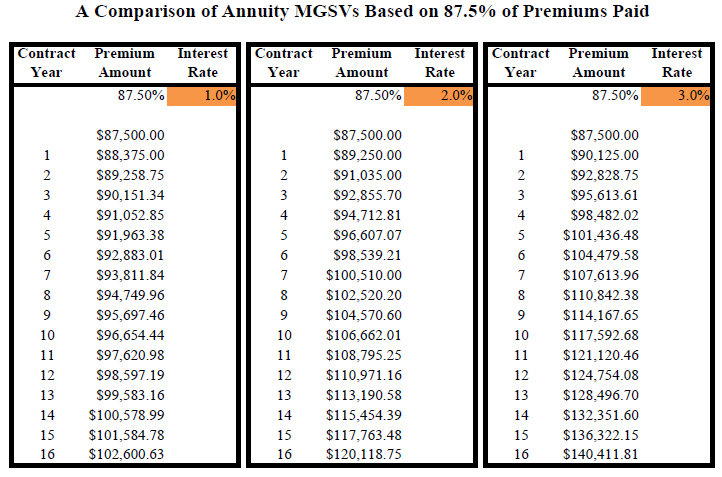All Categories
Featured
Table of Contents
Just as with a repaired annuity, the owner of a variable annuity pays an insurer a round figure or series of payments for the assurance of a collection of future payments in return. Yet as pointed out above, while a repaired annuity grows at a guaranteed, consistent rate, a variable annuity expands at a variable rate that relies on the performance of the underlying investments, called sub-accounts.

During the build-up stage, assets spent in variable annuity sub-accounts grow on a tax-deferred basis and are strained just when the contract owner takes out those earnings from the account. After the build-up stage comes the income stage. With time, variable annuity assets need to in theory enhance in worth until the contract owner chooses he or she wish to start taking out cash from the account.
The most significant concern that variable annuities usually existing is high cost. Variable annuities have a number of layers of fees and costs that can, in aggregate, produce a drag of up to 3-4% of the contract's value each year.
Understanding Financial Strategies Everything You Need to Know About Variable Annuity Vs Fixed Annuity Defining Annuity Fixed Vs Variable Features of Smart Investment Choices Why Choosing the Right Financial Strategy Can Impact Your Future How to Compare Different Investment Plans: Explained in Detail Key Differences Between Different Financial Strategies Understanding the Risks of Fixed Annuity Vs Variable Annuity Who Should Consider Strategic Financial Planning? Tips for Choosing the Best Investment Strategy FAQs About Variable Annuity Vs Fixed Indexed Annuity Common Mistakes to Avoid When Choosing Fixed Index Annuity Vs Variable Annuity Financial Planning Simplified: Understanding Your Options A Beginner’s Guide to Variable Annuity Vs Fixed Annuity A Closer Look at Fixed Annuity Or Variable Annuity
M&E expense charges are calculated as a percent of the agreement worth Annuity providers pass on recordkeeping and other administrative expenses to the contract proprietor. This can be in the type of a flat yearly fee or a portion of the agreement worth. Administrative fees might be consisted of as part of the M&E threat charge or might be evaluated separately.
These charges can vary from 0.1% for passive funds to 1.5% or more for proactively handled funds. Annuity agreements can be customized in a number of means to serve the specific requirements of the agreement owner. Some common variable annuity riders consist of assured minimal buildup advantage (GMAB), guaranteed minimum withdrawal advantage (GMWB), and ensured minimum revenue benefit (GMIB).

Variable annuity contributions supply no such tax obligation deduction. Variable annuities tend to be extremely ineffective cars for passing wide range to the future generation since they do not delight in a cost-basis change when the initial agreement proprietor dies. When the proprietor of a taxable investment account passes away, the cost bases of the financial investments held in the account are adapted to reflect the marketplace prices of those investments at the time of the proprietor's death.
Analyzing Annuities Variable Vs Fixed A Comprehensive Guide to Investment Choices What Is Fixed Vs Variable Annuity? Features of Smart Investment Choices Why Indexed Annuity Vs Fixed Annuity Is Worth Considering How to Compare Different Investment Plans: How It Works Key Differences Between Different Financial Strategies Understanding the Risks of Fixed Annuity Vs Equity-linked Variable Annuity Who Should Consider Strategic Financial Planning? Tips for Choosing the Best Investment Strategy FAQs About Planning Your Financial Future Common Mistakes to Avoid When Planning Your Retirement Financial Planning Simplified: Understanding Tax Benefits Of Fixed Vs Variable Annuities A Beginner’s Guide to Smart Investment Decisions A Closer Look at How to Build a Retirement Plan
Beneficiaries can inherit a taxable investment portfolio with a "clean slate" from a tax perspective. Such is not the instance with variable annuities. Investments held within a variable annuity do not receive a cost-basis change when the original proprietor of the annuity passes away. This suggests that any type of built up latent gains will be passed on to the annuity proprietor's successors, together with the connected tax burden.
One considerable concern connected to variable annuities is the capacity for conflicts of interest that might exist on the part of annuity salespeople. Unlike a monetary expert, who has a fiduciary task to make financial investment decisions that profit the client, an insurance broker has no such fiduciary responsibility. Annuity sales are extremely profitable for the insurance policy specialists who market them as a result of high upfront sales commissions.

Several variable annuity contracts have language which places a cap on the percentage of gain that can be experienced by certain sub-accounts. These caps prevent the annuity proprietor from fully joining a section of gains that can or else be appreciated in years in which markets create considerable returns. From an outsider's point of view, presumably that capitalists are trading a cap on financial investment returns for the aforementioned guaranteed floor on investment returns.
As kept in mind over, give up fees can significantly restrict an annuity owner's capacity to move properties out of an annuity in the very early years of the contract. Additionally, while most variable annuities enable agreement owners to take out a specified amount during the build-up stage, withdrawals past this quantity usually cause a company-imposed cost.
Withdrawals made from a fixed rates of interest financial investment choice might additionally experience a "market worth modification" or MVA. An MVA readjusts the value of the withdrawal to mirror any type of modifications in interest prices from the time that the cash was spent in the fixed-rate alternative to the moment that it was taken out.

On a regular basis, also the salesmen who offer them do not completely understand just how they function, and so salesmen sometimes exploit a customer's emotions to market variable annuities as opposed to the values and suitability of the products themselves. We think that capitalists should fully understand what they possess and just how much they are paying to possess it.
Decoding Fixed Annuity Vs Variable Annuity A Closer Look at Variable Vs Fixed Annuity What Is the Best Retirement Option? Benefits of Choosing the Right Financial Plan Why Choosing the Right Financial Strategy Is a Smart Choice How to Compare Different Investment Plans: Simplified Key Differences Between Variable Annuity Vs Fixed Indexed Annuity Understanding the Key Features of Long-Term Investments Who Should Consider Strategic Financial Planning? Tips for Choosing the Best Investment Strategy FAQs About Variable Vs Fixed Annuity Common Mistakes to Avoid When Choosing a Financial Strategy Financial Planning Simplified: Understanding Annuities Variable Vs Fixed A Beginner’s Guide to Smart Investment Decisions A Closer Look at How to Build a Retirement Plan
The same can not be said for variable annuity possessions held in fixed-rate investments. These assets lawfully come from the insurance provider and would as a result go to danger if the business were to fall short. Any assurances that the insurance coverage business has agreed to offer, such as a guaranteed minimum earnings benefit, would be in concern in the occasion of a business failing.
Possible buyers of variable annuities must recognize and think about the financial problem of the issuing insurance policy firm prior to entering into an annuity contract. While the benefits and downsides of different types of annuities can be questioned, the genuine problem surrounding annuities is that of viability.
Nevertheless, as the stating goes: "Purchaser beware!" This article is prepared by Pekin Hardy Strauss, Inc. Retirement savings with annuities. ("Pekin Hardy," dba Pekin Hardy Strauss Wealth Monitoring) for informative objectives only and is not meant as a deal or solicitation for service. The info and information in this write-up does not comprise legal, tax obligation, accountancy, financial investment, or various other specialist suggestions
Table of Contents
Latest Posts
Understanding Financial Strategies A Comprehensive Guide to Investment Choices What Is Fixed Annuity Vs Variable Annuity? Pros and Cons of Deferred Annuity Vs Variable Annuity Why Choosing the Right F
Analyzing Strategic Retirement Planning A Closer Look at Fixed Vs Variable Annuity Defining Fixed Interest Annuity Vs Variable Investment Annuity Pros and Cons of Choosing Between Fixed Annuity And Va
Decoding Fixed Interest Annuity Vs Variable Investment Annuity Key Insights on Your Financial Future Breaking Down the Basics of Variable Vs Fixed Annuities Advantages and Disadvantages of Different R
More
Latest Posts